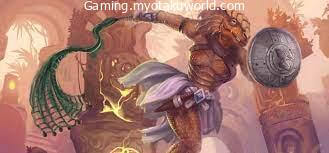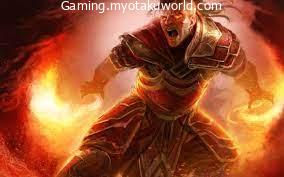A spell that could quickly replace Magic Missile as the preferred spell of wizards. Scorching Ray is a potent attack spell that can cause damage to several targets.
It is attractive due to its ability to focus the fire at a single target when it is desired.
The rules of Scorching Ray can be found in the Players Handbook on page 273.
Scorching Ray 5e

Evocation 2nd Level
Time to Cast: 1 Action
Range: 120 feet
Components: V, S
Duration: instantaneous
Three rays of fire throw the targets in the distance. They can be hurled at one target or several.
Create a spell that is ranged with each beam. When it hits, the target will take the damage of 2D6.
At higher levels, when casting this spell with the slot for spells of 3rd or higher, you create additional radiation for each slot level higher than 2nd.
The rules of Scorching Ray reveal key aspects of the ability. It can deal damage to multiple targets, or just one.
A base casting creates three separate rays with an attack that is ranged. The spell also can be extended to cause more damage.
Is Scorching Ray Beneficial?
Scorching Ray is a great combination of flexibility and damage. The base cast produces three rays which can be directed at one target at 6d6 damage, or multiple targets with 2d6 damage each.
The spell levels produce more rays, not only additional damage. The user can alter the direction of the attack and also the effects it has.
Turn economy can be a significant challenge for gamers if you encounter a scenario with several weak opponents.
This is especially relevant in situations where players haven’t yet reached the level of extra attack levels.
A wizard who is at the 3rd level is granted access to scorching Ray. Wizards can now take on 3 opponents simultaneously, which reduces the impact of turn economy.
At higher levels, the requirement to separate the rays becomes smaller, but it still serves a crucial purpose by making it necessary to conduct concentration tests.
The spellcasters of enemies need to perform concentration checks in the same way as character players.
Every ray counts as a hit and triggers an assessment for each hit. This is a huge advantage against the spellcasters who are invading your territory.
One of the greatest benefits of the spell is that it also has one of the most significant disadvantages, every individual ray is assigned a separate attack roll.
This stops one poor roll from ruining the entire attack, however, it could also mean that you can be casting a spell but only receiving a portion of the damage.
Does Scorching Ray Ignite?
There has been a long tradition of jokes about spells that use fire to burn down forests due to an unintentional shot.
Unfortunately, many of them aren’t attainable according to the rules. Scorching Ray falls into this category.
The rules of Scorching Ray do not specifically specify that the items struck by the rays explode.
Other spells like Fireball, Create Bonfire, and Fire Bolt all have a paragraph in their descriptions that specifically mentions that items will are ignited when they are hit in a certain way.
One thing that is particular about 5e in comparison to the other variants of 5e is that the words are utilized specifically.
House rules have been created to clarify the meaning of words however in 5e if the word isn’t explicitly stated that it isn’t happening.
Are you able to Twin Spell Scorching Ray?
A Twin Spell is a form of meta magic that is available to a sorcerer. The ability is described like this:
- When you cast a spell that targets only one creature and does not possess a self-range, it is possible to spend several sorcery points equal to the level of the spell to target another creature that is within the range of that same spell (1 sorcery point if the spell is one that cantrips).
- To be considered eligible, the spell must be unable to target multiple creatures at its current level. For instance, Magic Missile and Scorching Ray aren’t valid, but Ray of Frost and Chromatic Orb is.
As you will observe in the second paragraph, Scorching Ray is specifically mentioned. It is specifically mentioned because it targets one as well as more than one target.
If you have one target, however, it is possible to target a larger number of creatures, thereby not being able to twin.
This would apply to all other spells that are capable of being able to target multiple creatures.
Spells capable of only targeting one creature at level 1 are suitable for use in meta magic. Spells that target multiple creatures at higher levels cease being twinned.
For instance, Charm Person at 1 1st level is only able to focus on one creature and is not able to be twinned.
The Charm person at the 2nd level now has two targets and is therefore no more in the running to benefit from an effect known as the Twin Spell effect.
Is Scorching Ray better than Magic Missile at 2nd Level?
The Magic Missile is an iconic magic spell in all editions of the game. However, some say it’s not worthwhile to cast at a higher level.
The most popular replacement is Scorching Ray. A brief comparison of both is presented below.
Magic Missile is compared as being used at 2nd levels for this reason.
- The Magic Missile (2nd Level) creates four darts that deal 1d4+1 each (12 average damage/20 maximum damage). The Magic Missile can be used on multiple or single targets. It creates four separate concentration checks. Automatically hit for force damage.
- Scorching Ray (2nd Level) creates three rays that deal with each 2d6 damage. (18 avg damage/36 maximum damage). It can have multiple targets or just one target. It creates three separate concentration checks. An attack roll is required for each ray that hits to cause fire damage.
The spells come with a variety of situational variations, which could make one spell rank superior to the other.
The most important difference can be found in the fact that Magic Missile automatically hits, with force damage, while Scorching Ray might hit for fire damage.
Fire is by far the most commonly encountered resistance and force are the 2nd least frequently encountered resistance.
Final Words
Scorching Ray is a fantastic spell. It can be cast on either a single target or multiple targets and can deal decent damage.
The option of recasting the spell lets it remain in use when the character grows in levels.
The weak points of the spell are the separate attacks and the widely resisting fire damage kind. It is a fantastic strike spell that is suitable for every caster who allows for some flexibility.









